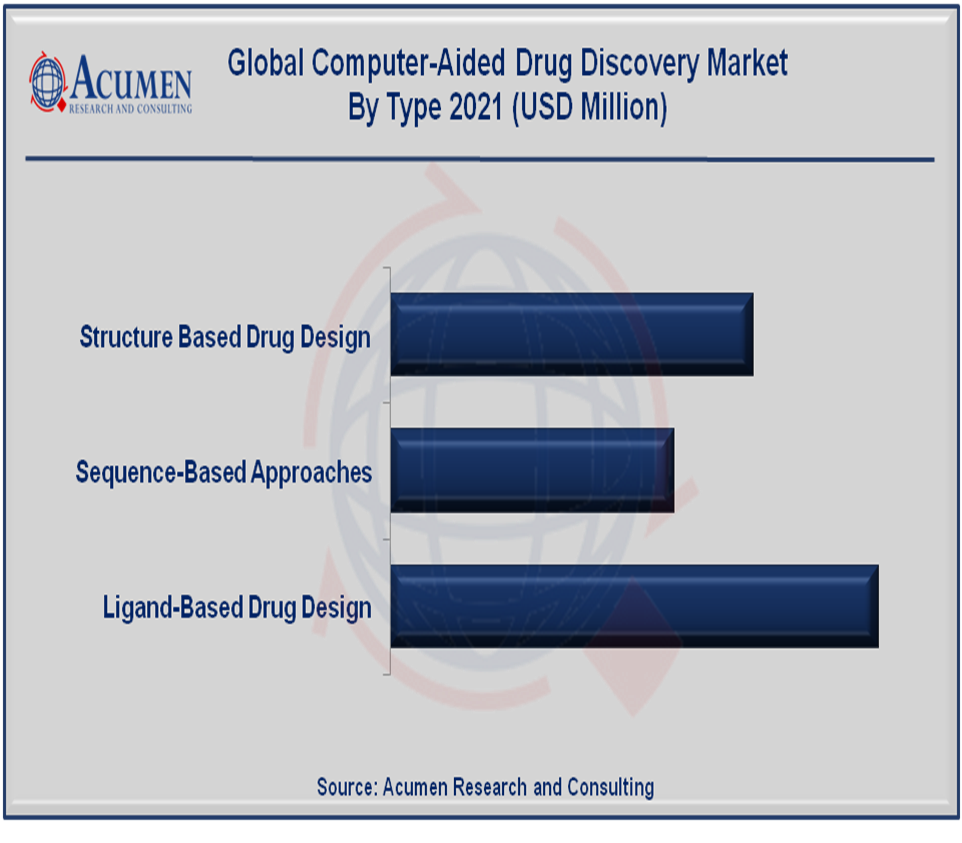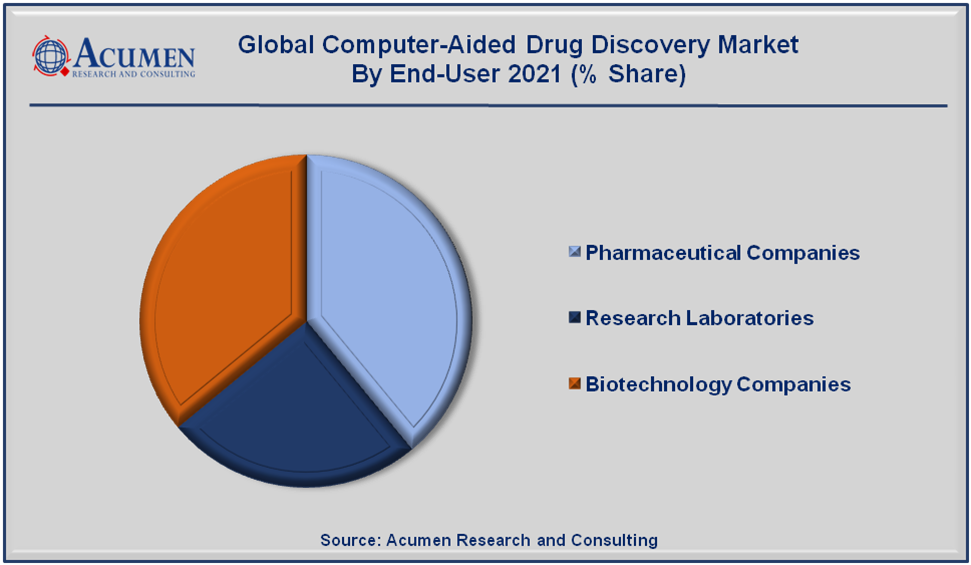October 2022
Computer-Aided Drug Discovery Market is predicted to be worth USD 7,232 Million by 2030, with a CAGR of 11.3%
The Global Computer-Aided Drug Discovery Market Size was valued at USD 2,845 Million in 2021 and is predicted to be worth USD 7,232 Million by 2030, with a CAGR of 11.3% from 2022 to 2030.

Increased incidences of chronic and undiagnosed diseases, as well as the development of precious pharmaceutical research, are projected to drive the computer-aided drug discovery market growth in the future years. Furthermore, the growing usage of artificial intelligence, machine learning, and IoT-based technologies in healthcare facilities for drug development will propel the computer-aided drug discovery market size forward.
Computational approaches are rapidly gaining acceptance, adoption, and appreciation in the drug research and development process. This field is referred to by various terms, such as computer-aided drug design (CADD), computer-aided molecular design (CAMD), computational drug design, computer-aided molecular modeling (CAMM), in silico drug design, rational drug design, and computer-aided rational drug design.
Computer-aided drug discovery is becoming an important component of a variety of initiatives in a variety of contexts and research environments. CADD has made significant contributions to the identification and optimization of hit compounds, advancing them to advanced phases of the drug development pipeline or the marketplace. CADD encompasses various theoretical areas, such as bioinformatics, molecular modeling, chemoinformatics, and data gathering. However, such strategies have developed and evolved alongside experimental methodologies employed in drug discovery and development.
Global Computer-Aided Drug Discovery Market DRO’s
Market Drivers
Market Restraints
Market Opportunities
Report Coverage
| Market | Computer-Aided Drug Discovery Market |
| Market Size 2021 | USD 2,845 Million |
| Market Forecast 2030 | USD 7,232 Million |
| CAGR During 2022 - 2030 | 11.3% |
| Analysis Period | 2018 - 2030 |
| Base Year | 2021 |
| Forecast Data | 2022 - 2030 |
| Segments Covered | By Type, By Therapeutic Area, By End-User, And By Geography |
| Regional Scope | North America, Europe, Asia Pacific, Latin America, and Middle East & Africa |
| Key Companies Profiled | Schrödinger, Inc., Charles River Laboratories, Bayer AG, Albany Molecular Research Inc., Aris Pharmaceuticals, Inc., Bioduro-Sundia, AstraZeneca plc, BOC Sciences, Aragen Life Sciences Pvt. Ltd., and OpenEye Scientific Software Inc. |
| Report Coverage |
Market Trends, Drivers, Restraints, Competitive Analysis, Player Profiling, Regulation Analysis |
| Customization Scope |
10 hrs of free customization and expert consultation |
Computer-Aided Drug Discovery Market Dynamics
The traditional approach to drug development and design is an exceedingly expensive and time-consuming process. A new drug development normally takes 10-14 years and billions of dollars to develop from conception to approval. The introduction of CADD has considerably reduced the time required for experimenting and testing. However, the growing demand for rapid pharmaceutical discovery for chronic illnesses such as diabetes and cancer is expected to increase the computer-aided drug discovery market value over the projection period. Furthermore, rising technical discoveries in the field of computer-aided drug discovery, as well as enhanced research activities to give accurate results in less time, are expected to drive the computer-aided drug discovery market trend.
Additionally, in recent years, deep learning (DL), which includes machine learning and artificial intelligence, has resulted in substantial scientific advancements with urgent implications for computer-aided drug creation. As a result, increased adoption of such technologies in the sector will fueled the market growth. Besides this, a dearth of qualified personnel to manage computer-aided drug development technologies may hamper global industry growth. Product uptake is also limiting the global computer-aided drug discovery industry in emerging market nations.
The Impact of Covid-19
The recent outbreak of the severe coronavirus virus (COVID-19) raises significant health and safety concerns around the world. The scarcity of approved treatments and immunizations continues to be an issue, prompting the discovery of novel medical substances. Computer-assisted drug discovery has aided in the acceleration of pharmaceutical research and development by lowering time and expense. However, as researchers, scientists, and microbiological and biopharmaceutical companies increased their R&D efforts to combat the coronavirus epidemic, the computer-aided drug discovery market trend accelerated.
Computer-Aided Drug Discovery Market Segmentation
The global computer-aided drug discovery market segmentation based on the type, therapeutic area, end-user, and geographical region.
Market by Type

Based on the type, the ligand-based drug design is estimated to hold the largest market shares over the predicting years. Ligand-based drug design is a technique that relies on knowledge about compounds that bind to the biological target of interest in the absence of receptor 3D information. The most important and widely used tools in ligand-based drug design are 3D quantitative structure-activity correlations and pharmacophore modeling. They have the ability to create prediction models that can be used to identify and optimize leads. Furthermore, emerging technologies, technological advancements, and rising demand for innovative therapies for various disorders are among the factors boosting the ligand-based drug design segment and computer-aided drug discovery market shares over the projection period.
Market by Therapeutic Area
In terms of therapeutic areas, the oncology segment will lead the market in 2021. Computer-aided drug discovery has developed as a successful and promising method for developing medications that are less expensive, faster, and more effective. The rapid development of computational approaches for drug discovery, especially anticancer drugs, has recently had a significant and remarkable impact on anticancer drug design, as well as valuable insights into the field of cancer therapy. Oncology is a medical specialty concerned with cancer treatment, prevention, and detection. As a result of the increased development of successful cancer drug discoveries, there is a higher demand for anticancer agents which are both effective and cost-effective. These crucial factors have the potential to boost segment growth during the projection timeframe.
Market by End-User

Based on the end-user, the market is further segmented into pharmaceutical companies, biotechnology companies, and research laboratories. According to the computer-aided drug discovery market forecast, the pharmaceutical companies segment is expected to grow significantly in the approaching years. Computer-aided drug discovery (CADD) is currently an essential component of a wide range of projects in a wide range of contexts and academic institutions. In order to improve research and innovation efficiency, major pharmaceutical companies have recently shifted their focus to computational approaches for the discovery and development of new medications. The two core approaches in computer-aided drug discovery (CADD) are structure-based drug discovery (SBDD) and ligand-based drug discovery (LBDD), and they can be employed in all of the trending pharmaceutical companies' drug development strategies.
Computer-Aided Drug Discovery Market Regional Outlook
North America
Europe
Latin America
Asia-Pacific
The Middle East & Africa (MEA)
North America is predicted to grow significantly in the worldwide market over the next few years. The rapidly increasing number of cancer patients in the United States is expected to boost revenue in the computer-aided drug discovery sector. Cancer is one of the rare fatal medical disorders that have no cure. The disease's prevalence is increasing at an alarming rate in the United States. The rapid expansion of the North American computer-aided drug discovery market is primarily driven by increasing research activities at institutes and hospitals, which have also established and upgraded their cancer investigation operations using computer-aided drug discovery.
Computer-Aided Drug Discovery Market Players
Some of the prominent global computer-aided drug discovery market companies are Schrödinger, Inc., Charles River Laboratories, Bayer AG, Albany Molecular Research Inc., Aris Pharmaceuticals, Inc., Bioduro-Sundia, AstraZeneca plc, BOC Sciences, Aragen Life Sciences Pvt. Ltd., and OpenEye Scientific Software Inc.
Looking for discounts, bulk pricing, or custom solutions? Contact us today at sales@acumenresearchandconsulting.com
October 2022
April 2021
November 2023
January 2021